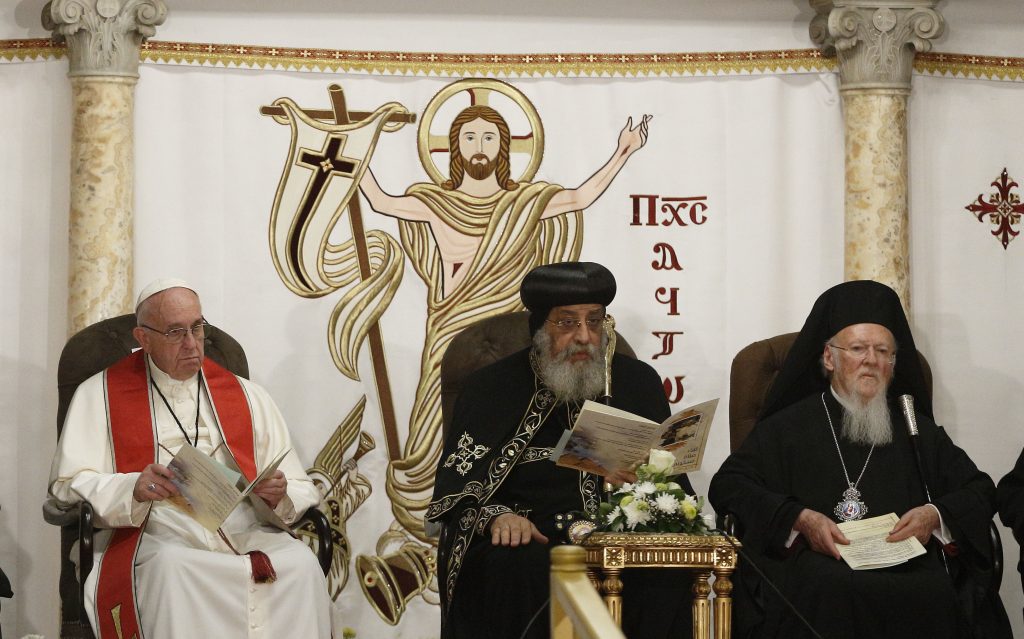So near and yet so far—let that stand in summary of the present situation of Roman Catholics and Orthodox Christians in the quest for full communion to which some of them, though apparently not all, are deeply committed. As matters stand, there’s no saying when—or even whether—the goal will finally be reached.
As is readily acknowledged on both sides, Catholics and Orthodox already have much in common—acceptance of the teaching of the first seven general councils of the Church, the sacraments including the Eucharist, and the apostolic succession of their bishops. It adds up to what Pope Francis, writing to Orthodoxy’s Ecumenical Patriarch of Constantinople, Bartholomew, recently called “a profound closeness” between the two bodies.
But serious doctrinal differences remain, with papal primacy—the universal jurisdiction of the pope—generally seen as most serious. Here, Pope Francis’s vision of “synodality”—regional councils of bishops with some jurisdiction over local churches in their regions—may point to a way of resolving the difficulty.
Beyond doctrine, however, there’s also the existential reality of much ugly history between East and West both before and since the definitive split in the year 1054. The hard feelings and suspicions that have festered in the millennium-plus since then won’t be overcome easily.
The key to progress beyond that already achieved during the last half-century through dialogue and friendly gestures rests with the Russian Orthodox Church, with slightly over 100 million members by far the largest body among worldwide Orthodoxy’s 260 million. For that reason if no other, Roman Catholics would do well to learn more about the Russian Orthodox than most probably know now.
Here a new 30-minute documentary film called “Faces Among Icons” offers an excellent introduction for parish and school groups trying to get up to speed in the wake of two notable anniversaries in the year now drawing to a close—the centenaries of the Bolshevik revolution in Russia and of the apparitions of the Blessed Virgin at Fatima, Portugal in which Mary urged prayers for Russia’s conversion.
Produced by the Catholic News Service, the film features interviews with church leaders and ordinary Russians who discuss the rebirth of faith in Russia after decades of persecution—and sometimes coopting—by an officially atheist regime. (Information available from [email protected].)
Another good source of information is a new Pew Research Center study pulling together recent data on Orthodoxy gleaned from a variety of surveys and sources. In brief, it’s a story of good news and bad news.
The good news is that the number of Orthodox Christians in the world has more than doubled in the past century. The bad news—for the Orthodox anyway—is that Orthodoxy’s growth lags far behind both Catholicism and Protestantism, with the latter two owing much of their expansion to rapid growth outside Europe while Orthodoxy, except for a significant presence in Ethiopia, has remained a largely European enmity.
Moreover, despite Russian Orthodoxy’s deep roots in Russian history and culture, just 6% of its members say they attend church weekly, while 15% say religion is “very important” in their lives, and 18% report praying daily. (But 87% have icons in their homes.) Disappointing, too, is the finding that only 17% favor restored communion with Roman Catholicism.
In sum, there’s work to do, and much of it can only be done by the Orthodox themselves. There is not a great deal Catholics can do to make that happen. Except, of course, pray a lot harder for our separated Orthodox brothers and sisters.
Russell Shaw, a contributing editor to Our Sunday Visitor, writes from Washington, D.C.
Interested in more? Subscribe to Angelus News to get daily articles sent to your inbox.

